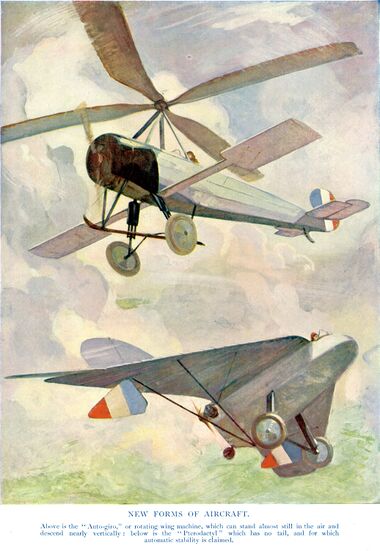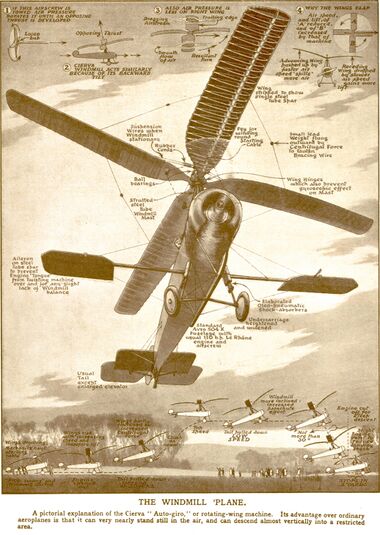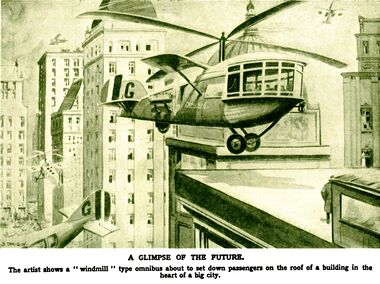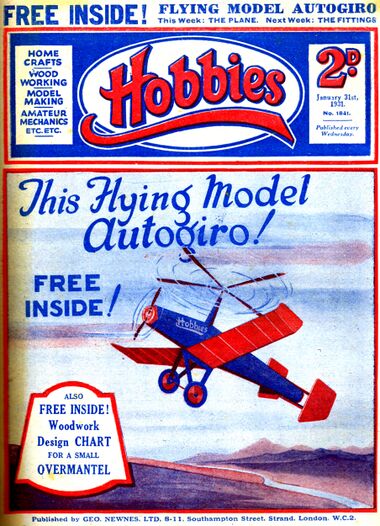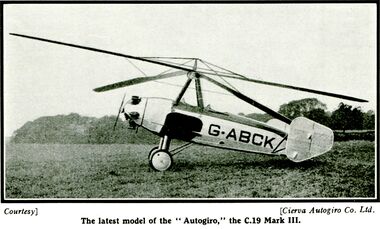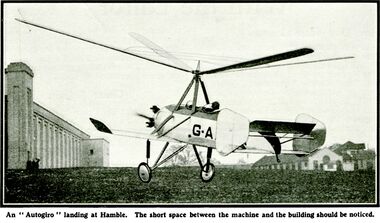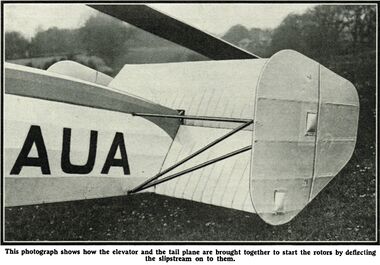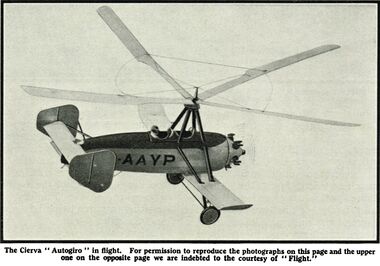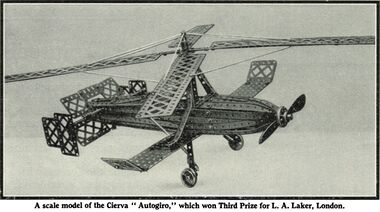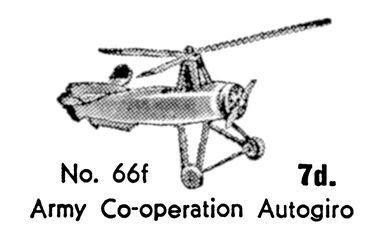Category:Autogiros
1928: New Forms of Aircraft [image info]
1928: "The Windmill Plane": Cierva Autogiro [image info]
1928: Autogiro Buses of the Future [image info]
1931: front cover of Hobbies magazine, with part one of plans to build a model autogiro [image info]
1931: Cierva C.19 mk III Autogiro [image info]
1931: Cierva Autogiro, landing at Hamble Aerodrome [image info]
1931: Tailplane detail: tilting the plane allows the exhaust plume to spin up the autogiro, even when stationary [image info]
1931: Cierva Autogiro in flight [image info]
1931: Prizewinning Cierva Autogiro Meccano prize model, Meccano Magazine [image info]
1940: Dinky Toys model, in army colours [image info]
The Autogiro (or autogyro, or gyrocopter) is a specialist type of light aircraft created in the later 1920s by Spanish aeronautical engineer Juan de la Cierva (1895-1936). Combining the horizontal propellor of a single-engined plane with an unpowered helicopter-like set of rotor blades that spun freely when the craft moved forwards through air ("autorotation"), the autogiro was stable and comparatively easy to fly, leading some commentators in the 1930s to suggest that road-capable autogiros might well be the future of personal transport.
Although it carved out a niche for itself as a small light-weight near-VTOL "spotter" and observation craft, and benefited from subsequent technological improvements, the Autogiro was eventually displaced for military and civilian activity by the helicopter, and for the "hobby flyer" activity by the powered hang-glider or microlight aircraft.
Spelling
Technically, one would expect "autogyro" to be spelled with a "y" in English, but Cierva (who basically invented the concept and produced all the early designs, in Spain) spelled it with an "i", resulting in this being the default spelling in all the early discussions of this type of craft (Cierva later trademarked "Autogiro"). An alternative name for the class of aircraft was "gyrocopter", but this also ended up being trademarked.
Juan de la Cierva
Juan de la Cierva (1895-1936) came from a wealthy family, which allowed him to study for the career he wanted, in aeronautics.
Haunted by by a fatal crash during testing of a conventional prototype military aeroplane that he'd designed, Cierva seems to have concluded that he did not want to risk going through this distressing experience a second time, and decided to commit himself to instead produce a new class of aircraft that couldn't "stall" on takeoff, and that would be safe and stable at low speeds.
In a world where the helicopter was still not yet a viable technology, Cierva's comparatively simple autogiro captured the imagination, and allowed him to build a successful business around the technology, gaining enough backing to start the Cierva Autogiro Company in the UK, in 1925.
Ironically, Cuerva died in 1936 at Croydon Airport, when the conventional Douglas DC2 airliner that he was riding in as a passenger crashed on takeoff, flying into a building in thick fog.
How an Autogiro works
The operation of an autogiro is rather counterintuitive: Naively, the rotors look like a propellor, and if they acted like an upward-pointed propellor, creating upward propulsion by driving air downwards, we would expect air to pass down through the props.
In fact, it passes upwards. When the machine is driven forward, air caught under the spinning prop region passes upwards through the angled blades, causing them to spin faster, and the lift effect is caused mainly by the high-speed rotors acting as wing surfaces, with their leading edges deflecting air away from the upper surface, causing a pressure differential and lift.
When an Autogiro falls
When the engine fails on an autogiro, it doesn't fall out of the sky like a rock:
- There is a certain amount of kinetic energy in the high-speed rotors, which keeps them spinning and creating lift.
- The long high-speed rotators cover a significant area and partially obstruct airflow, creating a certain amount of increased pressure under the blades (partial "kite effect").
- ... and, significantly, the energy lost by airflow moving upwards past the rotors causes the rotors to rotate faster, so in a sense, the autogiro's "fall" is powering the rotors that create lift to resist the fall.
Unlike a normal fixed-wing aircraft, the autogiro descends gracefully even when its horizontal speed is arbitrarily low (or zero!), with a drop-speed that has been compared to that of a parachute.
When an Autogiro moves
During powered flight, similar considerations apply: the rotors are tilted back so that the forward speed of the craft through the air catches air beneath the blades, causing them to spin faster, and creating more lift.
Other Autogiro advantages
Where the autogiro wins against fixed-wing craft is that a conventional aeroplane might need to be travelling at 100-280kph to achieve takeoff, requiring a long runway to achieve takeoff speed. With an autogiro, the spinning lifting surfaces can be moving at extremely high speed and allow takeoff while the craft is trundling forward at a puny 30kph. With a headwind, some autogiros can achieve almost a helicopter-style vertical takeoff. Using the kinetic energy in the blades, a pilot may manage an almost vertical controlled landing.
In a helicopter, a powerful engine in required to force the rotorblades to rotate, and the back-reaction forces cause the helicopter to rotate in the other direction. To stabilise the craft usually requires either a second set of contrarotating rotor blades (see: Kamov), or an extended tail with a vertically mounted rotor to compensate for contrarotation. This long tail and the powered couplings increase the helicopter's size, weight, and side-profile and vulnerability to enemy fire.
In order to brace itself against the wrenching forces caused by the powerful main rotor engine (and avoid tearing itself apart) a helicopter has to be structurally quite strong, further adding to the weight. In a gyrocopter, the rotor blades are unpowered and free-running, meaning that there are no rotational reaction forces that need to be resisted. The autogiro's structure does not need to be able to do much more than hang the weight of the engine, fuel and pilot from the rotor coupling. The low takeoff speed also means that wheels and wheel mountings can be more primitive and lightweight. The combination of all these factors allows autogiros to be absurdly small and lightweight compared to many other forms of aircraft.
The small body size and minimal runway size made autogiros useful in US and Japanese navies as "spotter planes" that could be operated from ships that weren't originally designed for aircraft. The low operating speed meant that some German submarines were able to use tethered unpowered autogyros as spotter craft, powered by just the forward motion of the dragging submarine, which would launch the craft and then tow it like a kite.
Development
- Before an autogiro can take off, the rotors need to be already spinning at perhaps half their operational rpm. This is enough to create the desired aerodynamic behaviour, so that forward speed on takeoff spins the blades up to their required speed. For the early prototypes, this initial spin was created by hand by assistants pulling on ropes wrapped around the rotor axle(!) Later version had a horizontal tail surface that could be tilted to direct the exhaust jet upwards through the blades to get them up to speed. Modern craft may have a "starter motor" fitted, or be able to briefly couple the main engine to the rotors at startup, although this increases the craft's complexity and weight.
- Extending the rotor shaft to a bottom coupling that could link to an external spinup drive allowed an autogiro's rotors to be brought up to operating speed while it was still stationary on the ground, after which the rotor could be adjusted away from horizontal, causing the machine to leap vertically up into the air (quite literally a "jump start") and commence "normal" flight.
- In order to achieve the impossible-sounding task of an incoming airflow causing the rotors to move so that the blunt leading edge moves preferentially into the wind, the early designs of rotor were sprung to automatically adjust their angle, so that the sharp trailing edge is angled to catch the wind (this dynamic response feature was one of the things that makes the autogiro so counter-intuitive – we may not understand intuitively how a fixed shape could have this behaviour, the answer is that it is not a fixed shape). Later designs borrowed "swashplate" technology from helicopters to automatically adjust blade angle at different parts of the rotor sweep, improving pilot control and allowing for significantly faster speeds. One problem with high-speed helicopters is the different characteristics of the blades on one side that move into the wind and those on the other side that move away from it – having the blades automatically alter their pitch depending on their direction of motion – "feathering" – helps with this).
Contemporary commentary
The Auto-Giro
The Air Ministry have been so impressed with the Auto-Giro built by Senor Cierva that they have placed orders with one of the leading aircraft manufacturing companies for the construction of four or five machines of this type. It is proposed to test to the full the possibilities of this curiously designed machine.
— , -, , Air News of the Month, , Meccano Magazine, , February 1926
Aerodrome over the Thames
It is becoming increasingly evident that it aviation is to become a popular method of transport between cities in the British Isles, arrangements must be made for speedier communication between the centres of the large cities and the associated aerodromes. In most cases these are at a considerable distance beyond the city boundaries, and when fights are made between cities not far distant from each other, it may be found that more time is occupied in travelling to and from the aerodromes than in actual flight.
A proposal that would overcome this difficulty was referred to on page 925 of the "M.M." for December, 1929. This was that the roofs of railway stations should be made flat and suitably or strengthened in order that they could be utilised as elevated aerodromes. Although excellent in many respects, this plan appears to be too costly to be put into operation. It has been estimated that the cost of converting Waterloo Station into an aerodrome of this type would be about £5,000,000!
It has now been suggested that autogiros should be used for transporting passengers from the centres of cities to aerodromes. Machines of this type would require only small landing grounds, and the cost and difficulty of providing these in congested centres therefore would be diminished. Much time also would be saved, for in the autogiros intending travellers could be carried swiftly to the existing aerodromes, where they would be transferred to ordinary air liners.
An aerodrome of this nature could easily be constructed in the heart of London by building a platform across the River Thames. The originators of the scheme claim that the cost of such a structure would be comparatively small, for it would not be necessary to build one strong enough to withstand the stresses to which an ordinary bridge is subjected. It is probable that the initial cost eventually would be recovered from the proceeds of the customary landing fees.
— , "Air News", , Meccano Magazine, , June 1930
The Cierva "Autogiro"
A Light Aeroplane that Cannot Stall or Spin
THE great majority of aeroplane accidents result from collision with another machine or with some obstacle when an aeroplane is landing or taking off, or from "stalling" or losing flying speed when the machine is near the ground, and consequently has not sufficient room to recover. Both these causes are the result of the necessity for a high speed to be attained before safety and stability can be achieved. In addition the correct use of the controls is essential to maintain this speed, for immediately the stalling point is approached, the controls of the average machine become quite ineffective. Generally speaking, therefore, the fundamental dangers of flight may be summed up as being due to the necessity of maintaining a high forward speed and to the lack of stability and control when this speed is lost.
Many machines have been designed and constructed in the endeavour to eliminate these difficulties, but the only one that has achieved any real success is the "Autogiro," invented by Senor de La Cierva, a Spanish aircraft designer. This is claimed to be the safest aeroplane in existence. The problem has been solved in this machine by ensuring that when it has ceased to move forward there are still forces acting on the wings. These forces are provided by windmill-like blades that keep moving at a high speed, and give such support to the machine that it drops only at a rate that involves no danger. The actual speed at which the machine falls is less than the rate of descent of a parachute. The method in which the rotors are hinged to the rotating shaft also ensures that the machine will be perfectly stable at low speeds, and even if the controls are misused a stall or crash cannot result.
De la Cierva first turned his attention to the "Autogiro" after a machine that he had designed for the Spanish Air Force crashed through stalling. This convinced him that aeroplane flight in which safety depended on speed was by no means ideal. Careful consideration of possible alternative systems of flight led de la Cierva to eliminate in turn not only the conventional type of aeroplane, but also the helicopter, an aeroplane capable of rising and descending vertically, and the ornithopter, a machine that attempts to imitate bird flight by deriving its lift from flapping wings. He became convinced that the solution lay in a machine having wings in the form of blades capable of rotating round a vertical axis.
De la Cierva's first experiments were commenced early in 1920, and many varieties of revolving blades were tested on various aircraft, without any practical result being obtained. in the first type tested the revolving surface consisted of two four-bladed windmills mounted on a vertical axis and driven in opposite directions by the force of the wind; but this did not solve the problem. Shortly afterwards a second type was evolved, in which there was only a single windmill fitted with three cantilever blades. The blades were hinged so that their degree of incidence, that is the angle at which they face the airstream, could be varied at will by the pilot in order to alter the resultant lift to right or to left. The first attempts with this machine were encouraging, but after it had been damaged and modified and reconstructed nine times in the course of experiments it became clear that the solution of the problem had not been found.
The third type of "Autogiro" was fitted with a lifting windmill made up of five rigid blades heavily braced to the axis by steel wires. This machine appeared to be an improvement on the others, but after it had been damaged and repaired four times it was found to be unstable and was therefore put aside in favour of a fourth machine. This type embodied the principle of articulated blades, which eventually proved to be the main solution of de la Cierva's problem. The machine had a single windmill with four blades hinged at the root, so that they could move freely up and down in the vertical plane without any change in their angle to the airstream. Lateral control was provided for by tilting the axis to right or left, but this control proved to be too difficult for the pilot to operate, and many crashes resulted. This machine was reconstructed or modified no less than fifteen times.
Eventually a better system of lateral control was provided, and in January 1923 a machine was completed that flew across the aerodrome at Getalfe, Spain. This machine subsequently carried out an officially observed and controlled four-minute flight over a closed circuit at the Guatro Vientos Aerodrome, Madrid.
Several other machines were produced after this, assistance being given to de la Cierva by the Spanish Government. One of these machines was demonstrated successfully at Farnborough in England, and at Villacoublay in France, and a similar machine constructed in 1925 by A. V. Roe & Co. Ltd. was demonstrated at the Hendon Air Pageant in 1926. The British Cierva Autogiro Co. Ltd. was formed in this country in that year, and now no less than twenty-one types of "Autogiros" have been constructed.
The modern "Autogiro" has a fuselage similar to that of any normal light aeroplane, but mounted above it on three supports rising over the front cockpit are four blades or rotors. These rotors are of aerofoil section and have a chord of 18.6 in. They are hinged at their attachments to the supporting pylon head to give them full freedom in both the vertical and the horizontal plane, and they provide 80 per cent of the total lift of the machine when it is travelling at a high forward speed. When the machine is descending vertically this proportion of lift is increased to 100 per cent.
In early types of the machine the rotors were started to revolve by winding a rope round the axis and then setting six or eight men to haul on the rope. Later the rotors were started somewhat in the same manner as a top by means of a mechanical contrivance on the ground; and an attempt was made also to start them by attaching rockets to their tips. Subsequently it was found that the rotors could be started by taxi-ing the machine round and round until they were in operation. In the latest model the empennage or tail unit has been so constructed that the tail plane and the elevator can be brought together to deflect the engine slipstream to the rotors while the machine in held stationary by means of wheel brakes. With larger land machines and with seaplanes a mechanical self-starter is provided. This derives its power direct from the engine crankshaft through a mechanically-operated clutch, and brings the rotors up to speed in less than 30 seconds. When the machine is in flight the clutch is completely disengaged and has no connection whatever with the rotation of the blades, thus eliminating all the torque reaction found in helicopters. A simple braking arrangement similar to the familiar wheel brake stops the movements of the rotors after the "Autogiro" has landed.
The "Autogiro" has also a small fixed wing that is used mainly to provide lateral stability and control in addition to improving the aerodynamic efficiency of the machine. This wing is used also as a base for the wide-track landing gear. It is interesting to note that the fixed wing does not stall even when the machine is descending vertically, as it is always in the downwash from the rotor. This fact has been proved by attaching a series of threads to each part of the wing. The Clerva Autogiro" in flight. When the machine was flown it was found that at all speeds from vertical descent to the maximum possible the threads showed a change in the angle of airflow of only a few degrees, and never approached an angle that would indicate that the fixed wing was in a stalled position.
In early models of the modern "Autogiro" it was found that the high centre of gravity, combined with the low fin area formed by the fuselage and vertical surfaces, rendered the machine laterally unstable at high speeds. This has been corrected in the present machine by setting the fixed wings at a substantial upward angle to the horizontal, and also by providing turned-up wing tips, giving the effect of high fin area.
The landing gear is of the wide-track divided axle type, and long-travel Oleo shock absorbers are used. The gear has been subjected to a great deal of strenuous service and has given complete satisfaction even after innumerable hard landings at the end of vertical descents with heavy loads. It is therefore considered as having been proved that the stresses on the landing gear of an "Autogiro" are less than those with ordinary aeroplanes of the same gross weight. These lower stresses make it possible to design parts of the fuselage and the fixed wing lighter than can be done in a normal aeroplane, with the result of a valuable saving in weight.
The "Autogiro' C.19 Mark III has a span and length of 35 ft., and is 10 ft. in height. The chord of the stabilising plane is 2 ft. 9 in., and it has an area of 42 sq. ft. The rotor blades have a total area of 91.25 sq. ft. The machine has a tare weight of 935 lb., and a loaded weight of 1,400 lb.; its maximum speed is 100 m.p.h. and its rate of climb 750 ft. per minute. It takes off in 30 yd., and there is no landing run or landing speed in still air.
The "Autogiro" is flown in a similar manner to an ordinary aeroplane. In order to take off the necessary revolutions of the rotor blades must first be obtained, and the brakes then released. The machine immediately begins to run forward in the normal manner, but takes off suddenly at a comparatively low horizontal speed, and maintains a fairly rapid climb at a slower forward speed than the conventional type of aeroplane. A notable feature when the machine is in flight is that bumps are hardly felt unless they are exceedingly strong; so that even in the worst weather there is little need to work the controls. When the pilot wishes to make a turn the rudder only need be used. The machine banks automatically unless the turn is very sharp, in which case the machine starts to turn flat before banking, and although the air speed drops there is no lack of lateral control. If the manouvre has been too sudden, all that happens is the loss of a few feet in turning.
In a normal landing, when the engine is throttled down, the "Autogiro" glides at any speed desired until a height of from 3 ft. to 10 ft. above the ground is reached, and then the " stick" is pulled hard back. The nose rises and the machine stops at once, dropping very slowly to settle gently on the ground. If a forced descent from engine failure or any other cause necessitates a landing in a small leld surrounded by high trees or similar obstructions, the machine can be made to drop slowly and vertically, but with perfect stability and still completely under control. With the" Autogiro" there is no need for the delicate handling that is essential in a normal aeroplane. The machine actually looks atfter a pilot who, owing to inexperience, or lack of judgment, has mistaken his height when flattening out; and the pilot is free from any anxiety due to thoughts of forced landings or accidents clue to engine failure. This makes it possible for the "Autogiro" to be operated in regions that are unsuitable for ordinary aeroplanes. It is ideal also for deck landing purposes and for use with ships in general.
Autogiros have not only been constructed as landplanes, but a seaplane version also has been produced; and work is now being carried out by Short Bros. Ltd. on an "Autogiro" flying boat. The principle has attracted a great deal of attention in America, and recently the American branch of the Cierva Autogiro Company received a contract for supplying a machine to the Chief Fire Warden of the State of New Jersey. The Fire Warden intends to experiment with the machine to determine whether it is suitable for aerial fire-fighting purposes. The United States Navy have purchased an American-built "Autogiro" for experimental work in co-operation with sea-going vessels not fitted with launching and landing apparatus. The French Government authorities also are interested in the machine, and in England an "Autogiro Puss Moth" constructed by the de Havilland Aircraft Co. Ltd., is shortly to make its appearance.
Discussions have taken place recently between the Cierva Autogiro Company and the British railway authorities with regard to the possibility of constructing fiat roofs over railway stations, from which "Autogiros" could operate. Nothing .definite has yet been decided, but the scheme is full of interest, for it would -enable travellers to make journeys between cities and their airports much more quickly than is at present possible.
It seems probable that the "Autogiro" is the machine of the future. Its safety and ease of operation will make flying possible for many people who are unable to develop the necessary skill to pilot an ordinary aeroplane. A beginner is able to take complete charge of an "Autogiro" after only a short period of dual tuition, for there is no danger of his getting into difficulties owing to loss of flying speed, or to a forced landing. The short space necessary for the" Autogiro" to take off is another feature of great value, for it means that the machine may be operated from a space no bigger than a good sized lawn.
— , -, , Meccano Magazine, , May 1931
In contrast to development on normal lines, there appeared at this time (1926) a heavier-than-air machine which was entirely novel in conception.
The Autogiro, designed by Señor Don Juan de la Cierva (1895-1936) is a machine which embodies some novel features in that it is provided with rotating vanes mounted on a nearly vertical mast which is situated above the centre of gravity of the machine. These rotating vanes, or wings, having been given an initial rotation while on the ground, are caused to continue to rotate by virtue of the forward motion of the machine — which is provided with a conventional type of body containing an engine with tractor airscrew — and thereby furnish the necessary lift. The principal advantage accruing from this type of heavier-than-air machine is that it permits of an almost vertical descent being made with safety, by virtue of the supporting surfaces being in rotation. The aerodynamics of this form of rotating-wing machine are of a complex nature, and it is not feasible to discuss the matter here. The Autogiro, as designed by de la Cierva, has been developed since its inception with remarkable success, and it has now been modified so that an initial vertical ascent is possible in addition to the almost vertical descent. Speeds exceeding 100 m.p.h. are also attained without sacrifice of those special qualities. The machine may well provide the ultimate solution of the problem of taking off and landing an aircraft in a very restricted space when such operation is essential.
— , M.J.B. Davy, , Interpretative History of Flight, , 1937
A NEW TAKE-OFF for the AUTOGIRO
By DON MARQUIS, '39
LAST winter at a meeting of the Royal Aeronautical Society of London the usual atmosphere of placid interest was replaced by hushed attention. The inventor of the autogiro had brought his brain child out of the closet where it had long' been concealed, and announced that it would soon be ready to meet all comers. To those present the autogiro had been a closed issue. Five years ago it had burst overnight into fame, but not into fortune, for it had failed to deliver the goods and was promptly shelved. "Just another freak." But now the foremost aeronautical minds of Great Britain and Europe were shocked into tense attention. They were being told that the autogiro had left the apron strings of the airplane and was emerging into a maturity with a promise of great things to come. "—and while we make no claim to superiority in every respect, we are convinced that we will not be far behind the airplane in what might be called airplane performance." The inventor of the autogiro stated quietly, and Juan De La Cierva, of a mildness to belie his brilliance, took his seat amid a buzz of comment.
"Airplane performance" had been the chief bugaboo of the autogiro. "Half the speed and half the load for twice the power" had been the jibe of airplane pilots. No one disputed that its abilities extended over a wider range than those of the airplane, but it could not compete with the latter in its own field. Another reason for its brief popularity was the difficulty of control. Although there were only 80 autogiros built in this country during the two years following its introduction here in 1931, 108 accidents occurred in the same period. True, they were, for the most part, of a trivial nature, and lacked fatalities entirely, but the autogiro showed an annoying lack of control at low speeds, and spot landings often ended in a tumble, with expensive repairs resulting.
So in 1933 the autogiro was taken from the market, and the efforts of its backers went into research. Now after two years of silence, the makers announce a new autogiro, purged of its, backwardness, and possessing abilities hitherto undreamed of.
If you happened to attend the 1937 National Air Show in New York City, you probably saw the "Roadable Autogiro" exhibited there by the Department of Commerce, which is experimenting with this new vehicle. The commuter of tomorrow may drive his autogiro from his standard sized garage through the streets to a vacant lot, unfold the vanes, and fly at more than 100 miles a hour to, perhaps, the roof of his office building. Plans made by the Department of Commerce to fly its pet exhibit to the entrance of Holland Tunnel and to proceed into the city on wheels were thwarted because the ship had not been equipped with an auto license!
This novel double nature of the autogiro was conceived by the Kellet Brothers, one of the two American manufacturers who have stayed with the machine. In the course of experimenting with pusher autogiros, they discovered that with the addition of a drive shaft, clutch, and other simple alterations, the airplane might be driven through the rear wheel. The propeller has returned to the ship's nose, but the motor stays behind the pilot, giving "roadability," and, which is especially important in this type of airplane because of its vertical descents, giving perfect visibility. The vanes, now the autogiro's sole lifting surface, can be folded onto the back of the ship; when they are folded it can be stored in an ordinary garage, and on the road takes no more space than a car.
Most spectacular of the autogiro's new abilities is the direct take off. The most recent machines can jump directly into the air to a height of 20 feet, and climb upwards from that point in the normal steep climb. This ability was developed by Cierva1 himself, and followed the clutching of the motor to the rotor to start it whirling before taking off. Cierva devised a means of flattening the pitch of the vanes so that they might be whirled very rapidly, storing up an excess of rotational kinetic energy. When they are allowed to bite into the air, the machine is pulled upwards, and is flying as soon as the rotor has slowed down.
Imagine the new possibilities opened to aircraft by this flying machine endowed with the talents of a helicopter. Soon every naval ship may have an autogiro, for it can literally land and take off from a handkerchief. The owner of an autogiro needs no expansive airport to make use of his machine. He may fly from his back yard. Rough water need no longer be a threat to the seaplane, for the autogiro will enter and leave it without any high speed contacts.
The old shortcomings of inefficiency and inability to carry a load are fast being overcome by theoretical and structural advances. Control has been perfected by shedding all airplane appurtenances except the rudder, and changing direction merely by tilting the rotor.
Just how does the autogiro stack up against the airplane? The latter can fly faster, and costs less. But the autogiro of today is flying 50 miles an hour faster than its predecessor, and the price will decrease as soon as quantity production is undertaken. Can the airplane maintain level flight at 16 miles an hour, hop into the air, or land vertically gently as a parachute? The autogiro cannot stall and does not have to maintain a minimum speed to fly as does the airplane. It is inherently much safer and is easier to learn to fly.
In comparing the autogiro with the airplane, it must be remembered that the former is still in its infancy. Not more than five or six men -have contributed anything to the autogiro, while a great school of aeronautical engineers has grown up dedicated to the cause of the airplane. As soon as the rotating vane craft are more generally recognized for what they are worth, progress will be, hastened by the efforts of those technicians who find it increasingly difficult to add anything of value to the fixed wing aircraft.
The autogiro, unique in its abilities, is expanding the horizon of the flying machine. In commercial work new services will be rendered, and a new field of private ownership will be opened so that the "family chariot" may yet be drawn by a Pegasus.
- The impetus behind Cierva's invention of a new flight principle was the fatal crash, during its test flight, of an airplane which he designed. His own recent death, which occurred ironically enough in the failure of a conventional airplane whose very type he strove to supercede, makes this picture of the autogiro as he left it the more timely.
— , Don Marquis, , Ohio State Engineer, , March 1937
In popular media
The most famous autogiro in the movies is probably ""Little Nellie" in the 1967 James Bond film, "You Only Live Twice". In the film, the autogiro is shipped to Bond in kit form and used to survay a volcano (which turns out to house SPECTRE's secret rocket-launching base). The bright yellow autogiro is equipped with a rockets, guns, parachute mines, air-to-air missiles and a flamethrower (!), and uses these to destroy four conventional helicopter gunships.
External links
Pages in category ‘Autogiros’
The following 10 pages are in this category, out of 10 total.
C
- Cierva Autogiro C-24 unbuilt kit (Skybirds 1)
- Cierva Autogiro C30P, Card No 07 (JPAeroplanes 1935)
- Cierva Autogiro, blue and yellow (Dinky Toys 60f)
- Cierva Autogiro, gold and red (Dinky Toys 60f)
- Cierva Autogiro, silver and red (Dinky Toys 60f)
- Cierva Autogiro, yellow and green (Dinky Toys 60f)
- Cierva Autogiro, yellow and red (Dinky Toys 60f)
Media in category ‘Autogiros’
The following 19 files are in this category, out of 19 total.
- Army Co-operation Autogiro, Dinky Toys 66f (MM 1940-07).jpg 1,436 × 885; 102 KB
- Army Cooperation Autogiro Cierva C30, box lid (Britains 1431).jpg 2,400 × 1,154; 641 KB
- Autogiro Bus of the Future (WBoA 6ed 1928).jpg 3,000 × 2,245; 1.76 MB
- Autogiro Working Model, Cierva C30, Britains 1392 (1935).jpg 2,400 × 1,412; 1.1 MB
- Bristol 173, Westland Sikorsky, and Autogiro C30 (Micromodels AV4).jpg 3,000 × 2,001; 2.43 MB
- C30 Autogiro, Card No 36 (GPAviation 1938).jpg 2,400 × 1,254; 356 KB
- Cierva Autogiro C-30P G-ACKA (WBoA 8ed 1934).jpg 3,000 × 2,319; 951 KB
- Cierva Autogiro C30P, Card No 07 (JPAeroplanes 1935).jpg 3,000 × 1,529; 530 KB
- Cierva Autogiro G-AAUA tailplane (MM 1931-05).jpg 2,400 × 1,675; 762 KB
- Cierva Autogiro G-AAYP (MM 1931-05).jpg 2,400 × 1,680; 657 KB
- Cierva Autogiro, at Hamble (MM 1931-05).jpg 2,400 × 1,406; 675 KB
- Cierva C19mkIII Autogiro G-ABCK (MM 1931-05).jpg 2,400 × 1,449; 646 KB
- City of the Future (WBoA 8ed 1934.jpg 2,024 × 3,000; 1.43 MB
- Flying Model Autogiro, Hobbies no1841 (HW 1931-01-31).jpg 1,805 × 2,500; 3.56 MB
- Meccano Autogiro model (MM 1931-10).jpg 3,000 × 1,670; 974 KB
- Meccano Autogiro prize model, LA Laker (MM 1931-10).jpg 2,400 × 1,336; 703 KB
- New Forms of Aircraft (WBoA 6ed 1928).jpg 2,069 × 3,000; 1.35 MB
- Rota Autogiro, FROG Penguin (MM 1939-02).jpg 1,600 × 867; 112 KB
- The Windmill Plane, Cierva Autogiro (WBoA 6ed 1928).jpg 2,132 × 3,000; 1.57 MB
